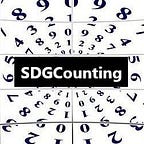SDG 12 Indicators- 2017 Updates
The updated list of SDG #12 Indicators since July 2016, with changes highlighted.
In summer 2016, we created a series of Medium stories listing the targets and indicators for the Sustainable Development Goals. Since then, meetings have been held that have altered and edited the global indicators framework. Here, we highlight the changes and additions that have been made since July 2016 up to April 2017, to update our indicator stories before the High Level Political Forum takes place in July 2017.
*Changes and additions to indicators are italicized, along with notes from the IAEG-SDGs as to the purpose of the edit. Goal 12 have no changes, but indicators 12.2.1, 12.3.1, 12.4.2, 12.5.1, 12.6.1, 12.7.1, 12.8.1, 12.a.1, 12.b.1, and 12.c.1 are considered Tier 3.
SDG 12: Responsible Consumption and Production — Indicators by Targets
Target 12.1. Implement the 10-Year Framework of Programmes on Sustainable Consumption and Production Patterns, all countries taking action, with developed countries taking the lead, taking into account the development and capabilities of developing countries
Indicator 12.1.1: Number of countries with sustainable consumption and production (SCP) national action plans or SCP mainstreamed as a priority or a target into national policies
Target 12.2. By 2030, achieve the sustainable management and efficient use of natural resources
Indicator 12.2.1: Material footprint, material footprint per capita, and material footprint per GDP
Repeat of 8.4.1
Indicator 12.2.2: Domestic material consumption, domestic material consumption per capita, and domestic material consumption per GDP
Repeat of 8.4.2
Target 12.3. By 2030, halve per capita global food waste at the retail and consumer levels and reduce food losses along production and supply chains, including post-harvest losses
Indicator 12.3.1: Global food loss index
Target 12.4. By 2020, achieve the environmentally sound management of chemicals and all wastes throughout their life cycle, in accordance with agreed international frameworks, and significantly reduce their release to air, water and soil in order to minimize their adverse impacts on human health and the environment
Indicator 12.4.1: Number of parties to international multilateral environmental agreements on hazardous waste, and other chemicals that meet their commitments and obligations in transmitting information as required by each relevant agreement
Indicator 12.4.2: Hazardous waste generated per capita and proportion of hazardous waste treated, by type of treatment
Target 12.5. By 2030, substantially reduce waste generation through prevention, reduction, recycling and reuse
Indicator 12.5.1: National recycling rate, tons of material recycled
Target 12.6. Encourage companies, especially large and transnational companies, to adopt sustainable practices and to integrate sustainability information into their reporting cycle
Indicator 12.6.1: Number of companies publishing sustainability reports
Target 12.7. Promote public procurement practices that are sustainable, in accordance with national policies and priorities
Indicator 12.7.1: Number of countries implementing sustainable public procurement policies and action plans
Target 12.8. By 2030, ensure that people everywhere have the relevant information and awareness for sustainable development and lifestyles in harmony with nature
Indicator 12.8.1: Extent to which (i) global citizenship education and (ii) education for sustainable development (including climate change education) are mainstreamed in (a) national education policies; (b) curricula; © teacher education; and (d) student assessment
Target 12.a. Support developing countries to strengthen their scientific and technological capacity to move towards more sustainable patterns of consumption and production
Indicator 12.a.1: Amount of support to developing countries on research and development for sustainable consumption and production and environmentally sound technologies
Target 12.b. Develop and implement tools to monitor sustainable development impacts for sustainable tourism that creates jobs and promotes local culture and products
Indicator 12.b.1: Number of sustainable tourism strategies or policies and implemented action plans with agreed monitoring and evaluation tools
Target 12.c. Rationalize inefficient fossil-fuel subsidies that encourage wasteful consumption by removing market distortions, in accordance with national circumstances, including by restructuring taxation and phasing out those harmful subsidies, where they exist, to reflect their environmental impacts, taking fully into account the specific needs and conditions of developing countries and minimizing the possible adverse impacts on their development in a manner that protects the poor and the affected communities
Indicator 12.c.1: Amount of fossil-fuel subsidies per unit of GDP (production and consumption) and as proportion of total national expenditure on fossil fuels
